Few bird keepers won’t have encountered the Bengalese or Society finch, those ever friendly and reliable little birds that are the basis of many an aviary alongside the Zebra Finch. But how many of us know the rest of the family?
Known as the mannikins, munias or even nuns, this is a group of thirty-some different species, including the wild forerunner of the Bengalese. And while these birds aren’t the fanciest to look at they are certainly interesting, attractive and a great addition to any bird room.
Lonchura
The name for the group of species is Lonchura and are spread across Africa to South Asia including India, Sri Lanka, Philippines and Indonesia. These birds are generally small seed eaters that live in a variety of habitats but most often with reeds and grasses on which they perch.
These birds are popular in captivity around the world but not all the species have been kept in the UK or are kept any longer. So here we are going to glimpse the most popular species that bird keepers are mostly likely to get the chance to own. The two species that will be omitted and featured elsewhere will be the Java and the Timor Sparrow.
Black and white manikin
The black and white mannikin (Lonchura bicolor) is now rarely seen in aviculture in the UK. Part of the problem is the number of subspecies and hybrids between these and other species leading to less impressive birds. Their natural look is a bottle blue and black colour with white contrasting areas and make for a striking appearance.
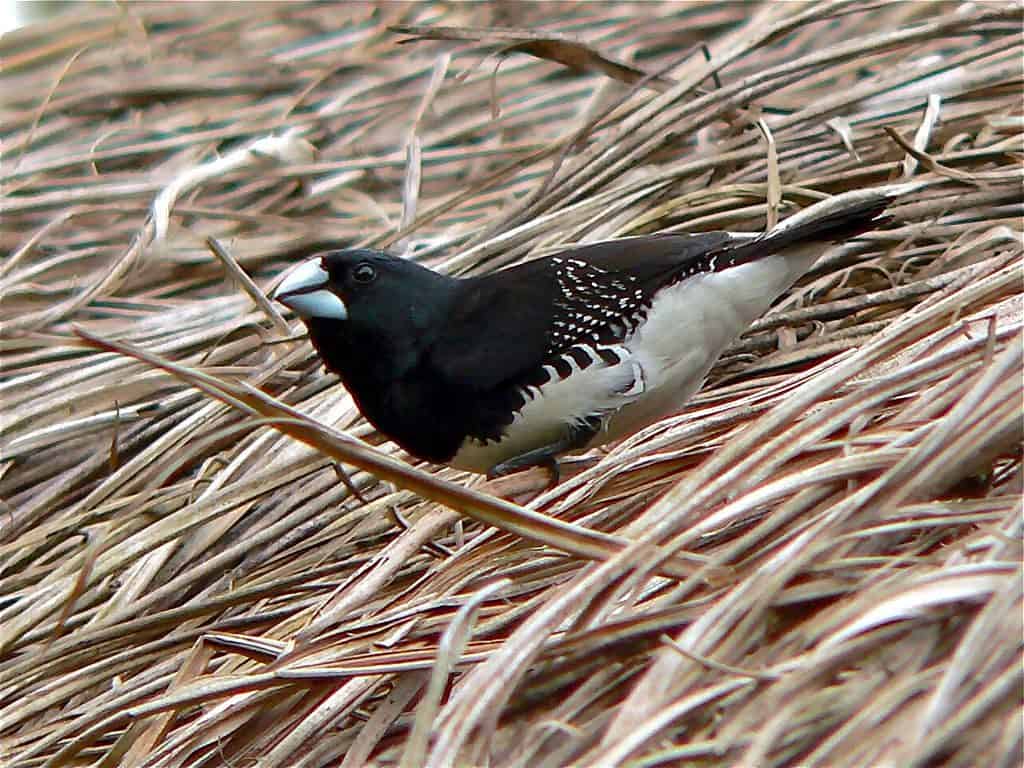
These birds are normally quiet and sociable, managing well in a colony system. However, they can be aggressive and use the raised wing technique to make themselves appear more impressive. Some keepers note a murderous streak including killing fledglings of other species but this isn’t a frequent event. Part of this may be due to them taking other birds’ nests and redesigning it for their own use.
Frequent bathing is important to maintain the shine of their feathers. Otherwise the birds are easy to keep and enjoy live food as well as other types of food.
Bronze winged mannikin
The Bronze or bronze winged manikin (Lonchura cucullata) is found across large parts of Saharan Africa where it lives in open areas near water. These little birds are known for being tiny terrors, having a strong personality and aggressive nature, despite their diminutive size. When confronted with a larger bird, they will raise a wing behind themselves to create the appearance of a greater size and make a rattling noise. Nor do they back down easily!
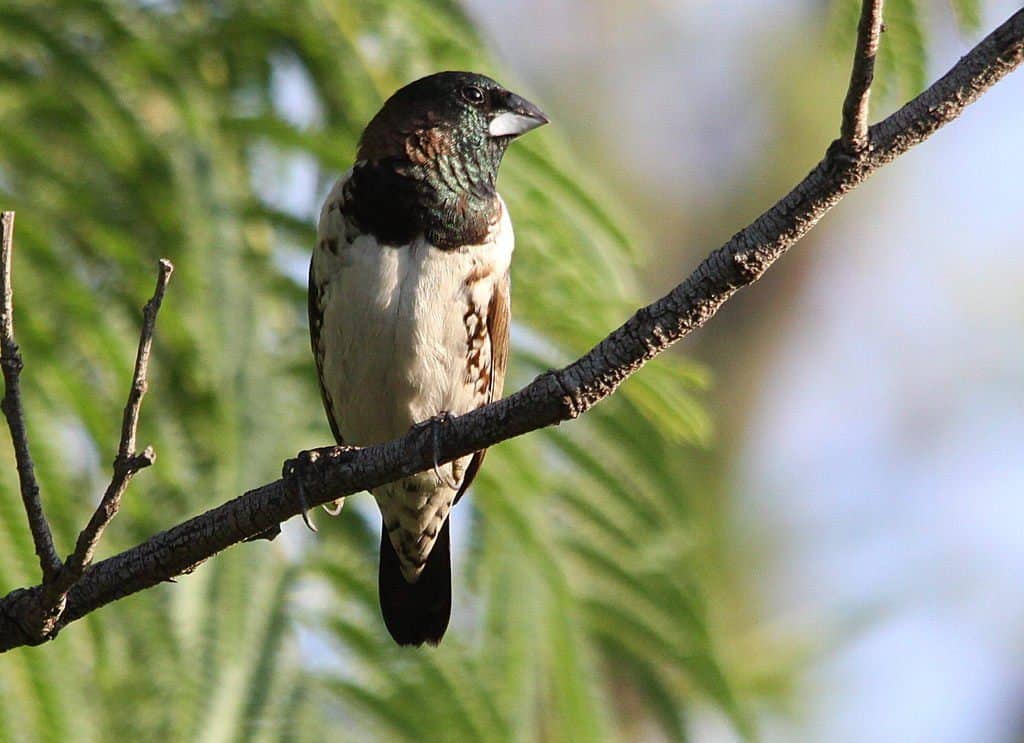
Apart from being aggressive when confronted, these little mannikins are active and otherwise quiet little birds whose subtle colours are brought out best in natural light. Sexing them is difficult as both sexes look much the same but holding two birds beside one another, the hen’s colouration is a little duller and she is slightly smaller in size. The hen’s bib is often a little smaller than the cock and there may be a broken edge.
Their slightly aggressive side can come out with each other during breeding and keepers say that sometimes the hen needs a break and the pair are separated. The birds tend to enjoy live food but not bother soft food as much and a calcium supplement is needed as they rarely bother cuttlefish. Egg binding and soft shelled eggs can be an issue because of this.
Chestnut breasted mannikin
After the Bengalese and the Silverbills, the Chestnut breasted manikin (Lonchura castaneothorax) is one of the more commonly seen members of the family. These attractive birds have a black or dark brown face, a greyish head and copper coloured chest, darker shades on the back. Their belly is an off-white with attractive markings along their flanks. There are a total of six subspecies and seven forms of the bird including the ‘sharpii’ subspecies that is often found in captivity. They are native to Australia, New Caledonia, Indonesia and Papua New Guinea.
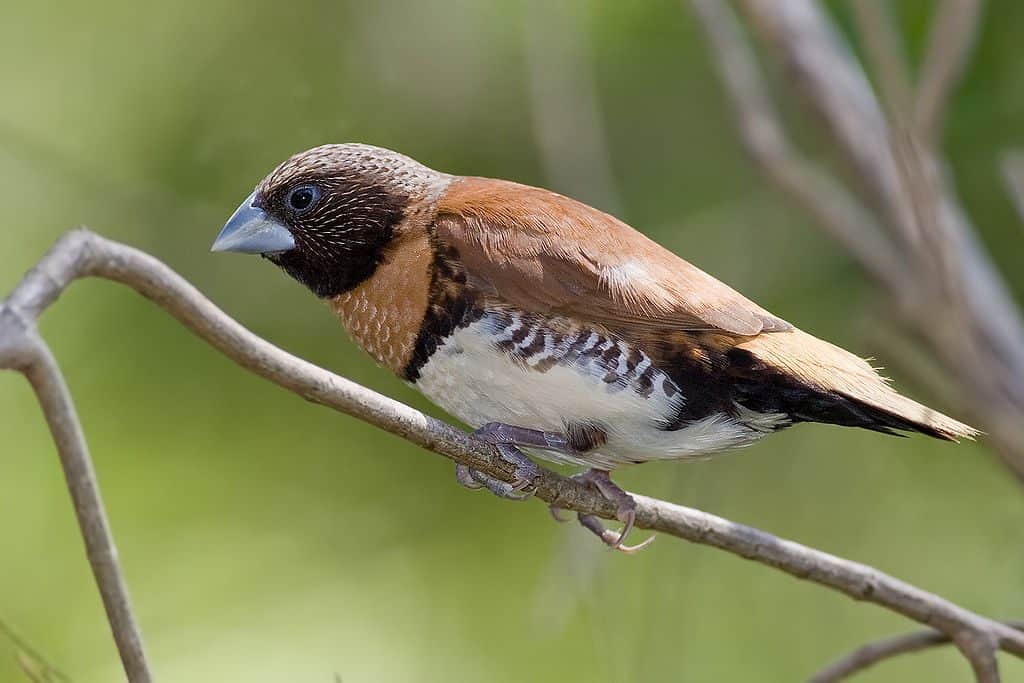
Their native habitats range from reed beds and grasses alongside river to swampy areas and mangroves. They favour areas with cereal crops and cane fields while always staying near water. They live in large flocks outside breeding season and separate into pairs to rear their young. They are confident birds in a mixed aviary, sometimes almost a bit bossy and will help out in other birds’ nests if allowed.
Dusky mannikin
The Dusky mannikin (Lonchura fuscans) is a dusky brown colour but often looks almost black depending on the light. These birds are endemic to Borneo and live in lowland tropical shrub, forest or grassland habitats. In captivity, they are quiet and friendly birds that live well with others and often group together when more than two are present.
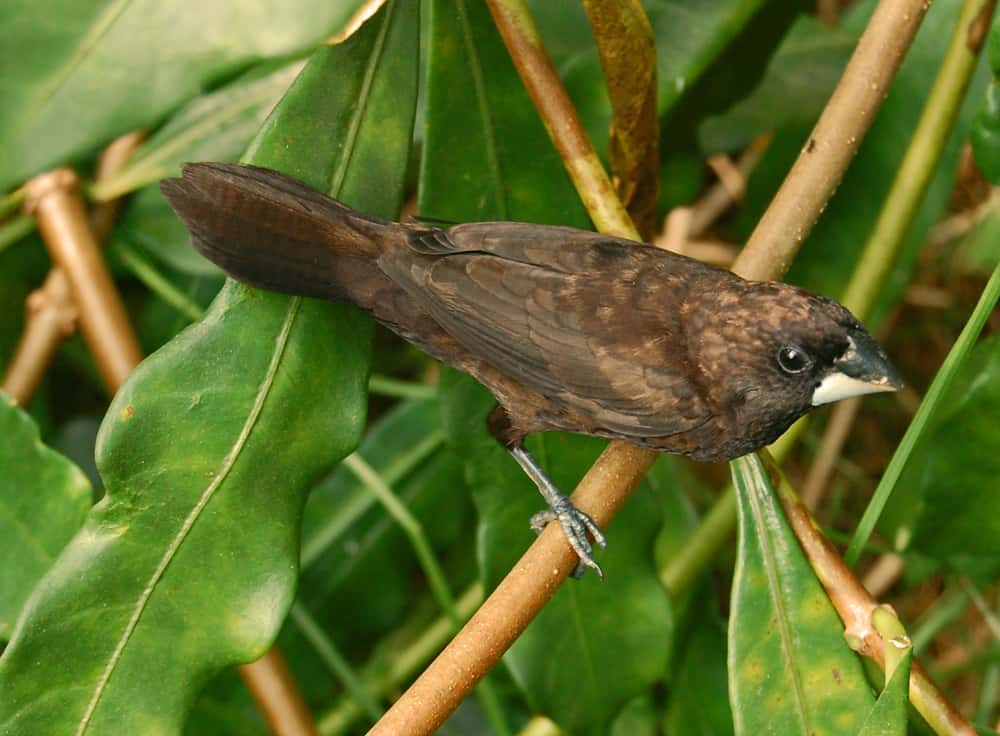
Currently, I have two pairs in a cage, both the hens being young birds so am hoping they may settle enough to breed. They live with a pair of Owl Finches and a trio of Masked Grass finches, all of whom seem to get along well. The Dusky has a pleasant song that can be heard quite easily and sits upright to sing.
Grey headed silverbill
Also known as the pearl headed silverbill or mannikin, this is the ‘other’ silverbill species to the commonly seen Indian and African silverbills. The grey headed silverbill (Lonchura griseicapilla) is found across eastern Africa and is a stocky bird with a grey head spotted with white. It has a grey-brown body with black wings and tail, measuring around 11.5 cm in length. They are often found in the wild with the Indian silverbill and in flocks, where they feed on grass seeds.
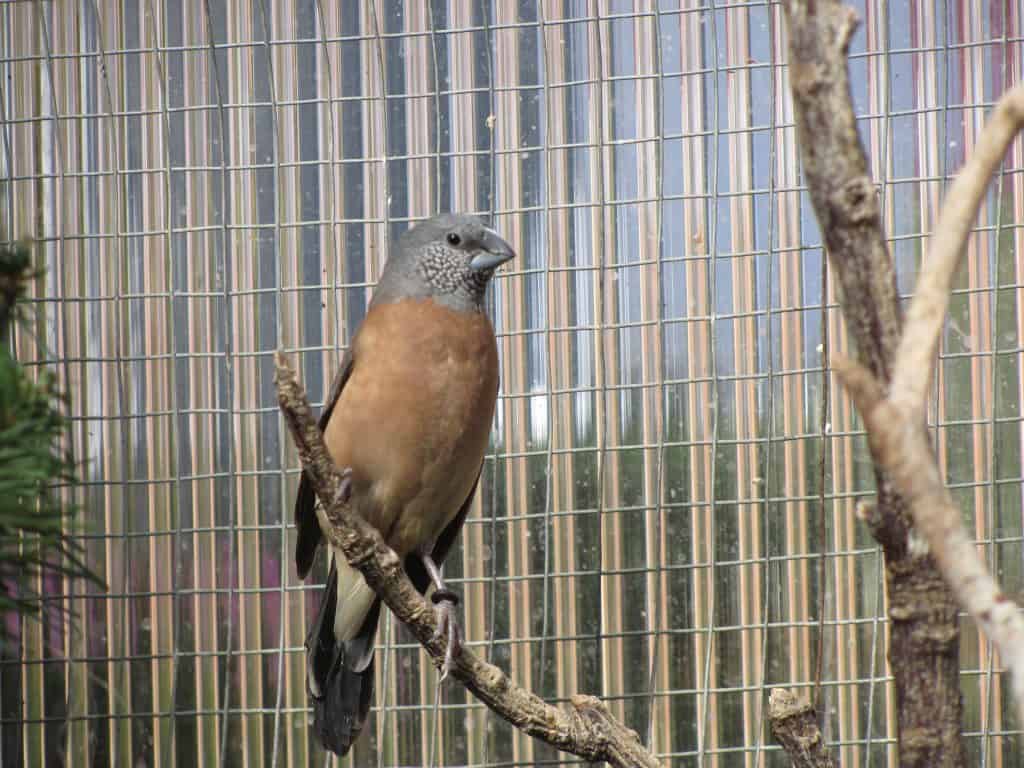
My experience with this species was a single pair that I had for some time, first in a cage then in a flight. I found them a little uptight in the cage, hence their change of location, but in the flight they were little terrors! They would bully other birds and physically throw smaller species from a food bowl. Unfortunately, I lost the hen before I could get them to breed so who knows if their behaviour would have become better or worst at this stage – I would be interested to see if other breeders noted similar behaviour.
Hooded mannikin
The Hooded or New Britain manikin (Lonchura spectabilis) is a species found across West Papua, Indonesia and Papua New Guinea. Their natural habitat is the foothills and mid-montane grassland as well as areas that have been cleared. There are a total of eight different forms of the bird across five subspecies so minor variations in their appearance isn’t unusual.
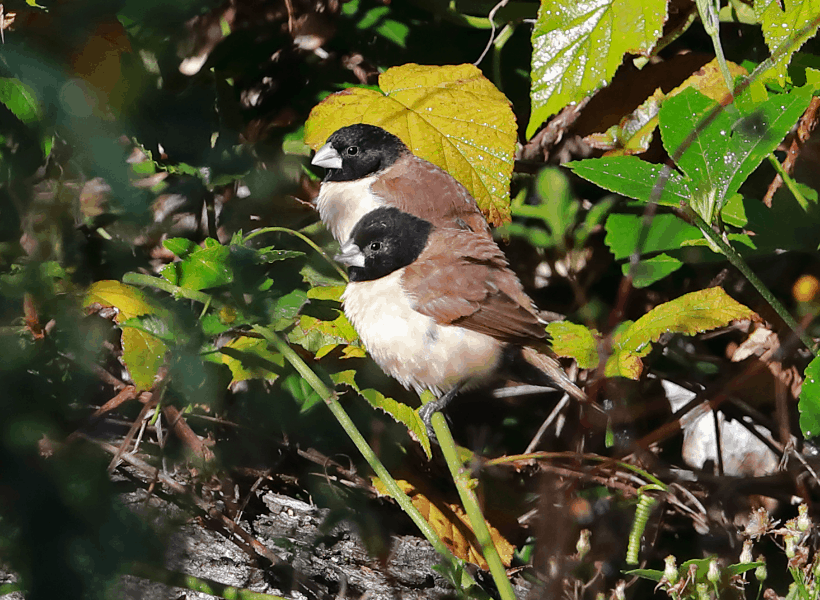
In captivity they are often confident little birds that will almost become tamed and don’t automatically flee from their keepers. They have a guttural and complex song that is a surprise from such a small bird.
Their diet is much as with other mannikins though breeders have found that they can lose condition speedily if they aren’t provided with soft food. Live food may be taken but again isn’t compulsory. In the wild, they eat the seeds of a grass called Rottboellia exaltata that has been introduced to their habitats and produces large seeds around the size of rice grains.
Magpie mannikin
The Magpie mannikin (Lonchura fringilloides) is one of the larger species in the mannikin family and is found across southern and central Africa. These birds have a reputation as being aggressive but this is more often the case in cage situations than in larger flights as they prefer some personal space. Their large, sturdy beak means they can look after themselves if anyone gives them any trouble!
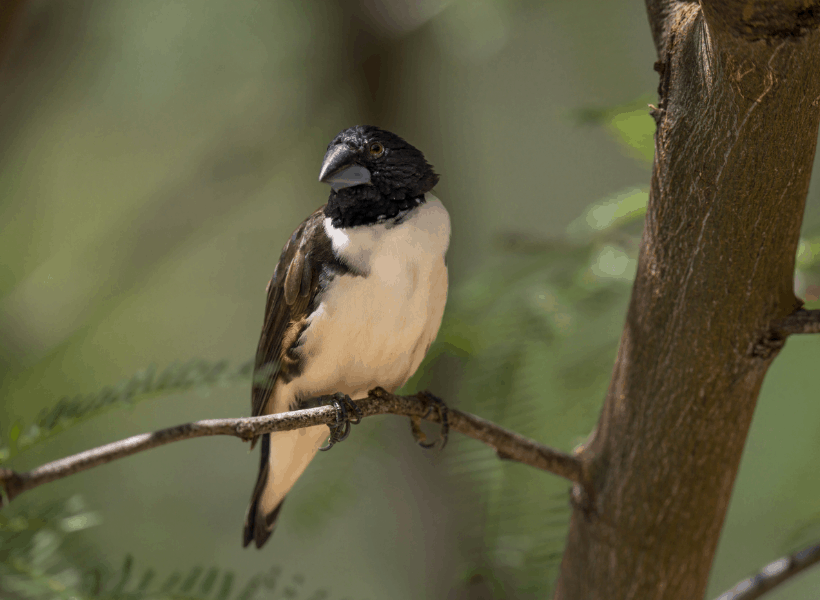
Another interesting fact about these birds is that their song is virtually inaudible – you can see the cock singing but you can rarely hear him. Full courtship displays include a bizarre move where the bird sticks out its tongue and waggles it from side to side.
They are easy to feed and enjoy both life food and soft food but otherwise a good finch diet will be ideal. They are also particularly stringent in their bathing routine so bath water should always be available.
Moluccan mannikin
The Moluccan or Black-faced manikin (Lonchura Molucca) is another of the smaller manikin species, with a black head, tail, belly and under-tail coverts while the back is rufous brown and the chest is a white with black markings. The bird is native across the Wallacea islands of Indonesia as well as having been introduced to South America.
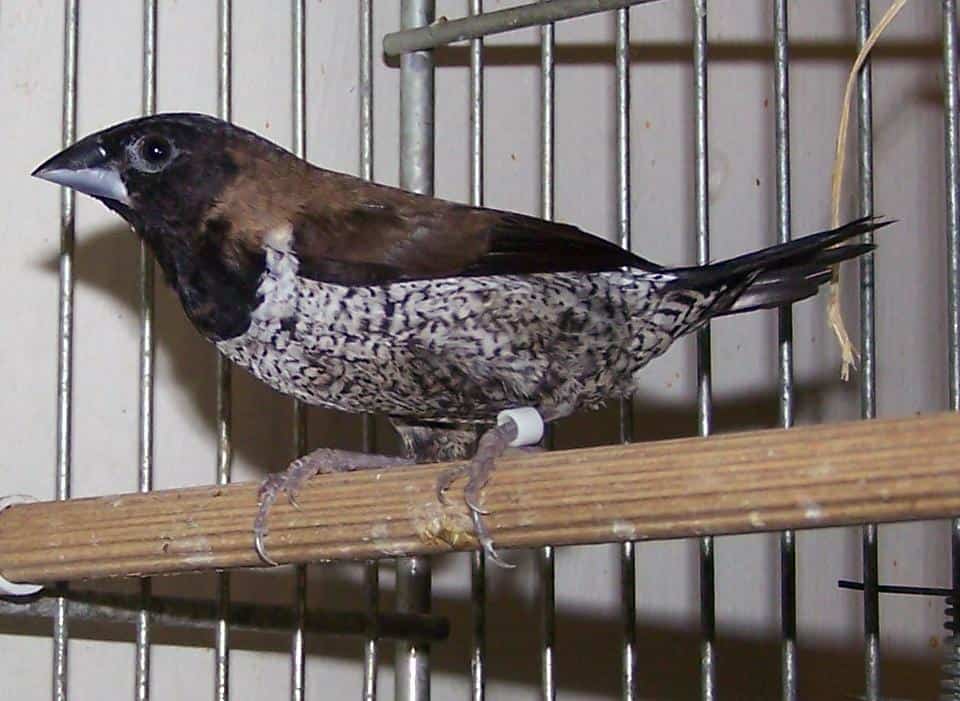
These little birds are generally very content to do their thing in a mixed aviary, though I have seen them sometimes hanging around with the Bengalese. Their song is louder than some of the other manikin species, who are seen to sing rather than heard. The males often overgroom their mates, resulting in hens with bald patches at the back of the neck.
While I have yet to breed these birds, they did have a clutch of eggs in a wooden half open front nest box and sat well past the time that chicks would have hatched.
Scaly breasted munia
The Scaly breasted munia (Lonchura punctulata) is often also known as the nutmeg mannikin or the spice finch. These distinctive looking birds have a rich brown head, lighter brown back and paler brown tail with a touch of yellow to the feathers. The breast gives them their name with a bold scale-like pattern to the feathers. There are a total of 11 subspecies of the bird that are found across Asia from India and Sri Lanka to the Philippines and Indonesia.
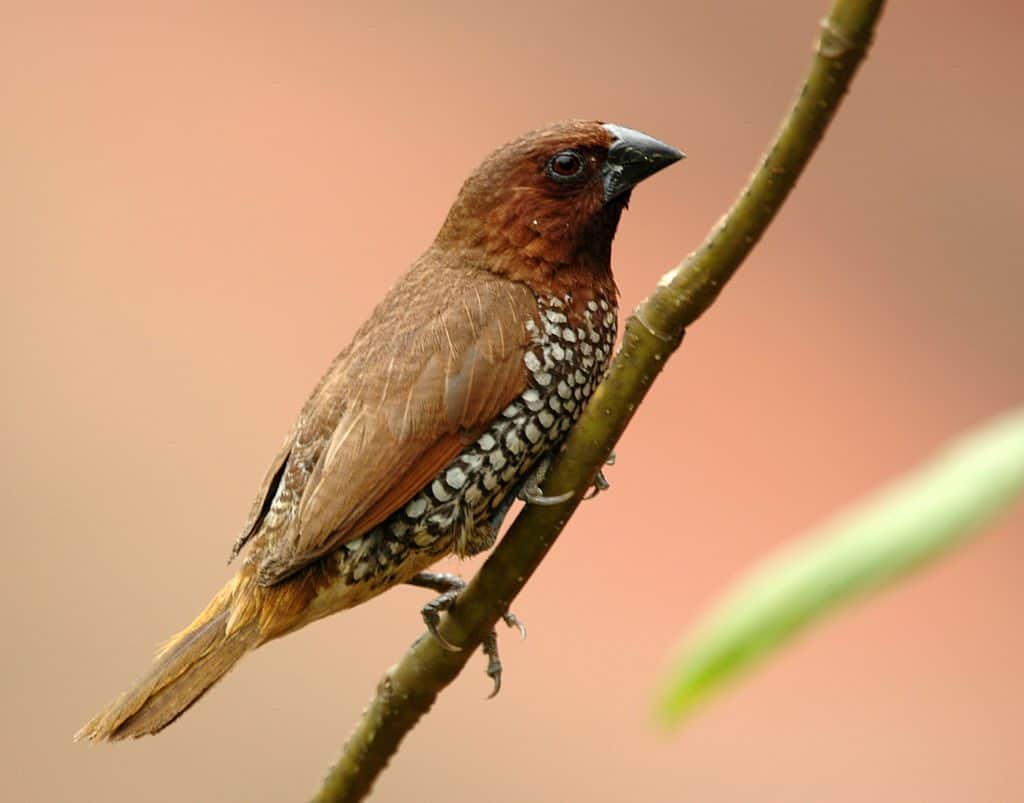
In the wild, these birds live in colonies of up to 100 birds so living together with others in captivity is natural for them. They use communal roosts and preen each other around the face and neck, known as allopreening. They have a very attractive song that is similar to the Bengalese in my opinion, though more complicated and musical. Sexing them can be difficult though the males have darker markings and their throat tends to be a darker colour.
Silverbills
After the Bengalese, perhaps the most well-known members of the family are the two silverbill species, the African and Indian. The African silverbill is found in the dry savannah areas to the south of the Sahara Desert as well as in introduced population in Portugal, the USA and in Qatar.
The Indian silverbill is found across the Indian subcontinent as well as in drier areas of the Middle East and has been introduced around the world.
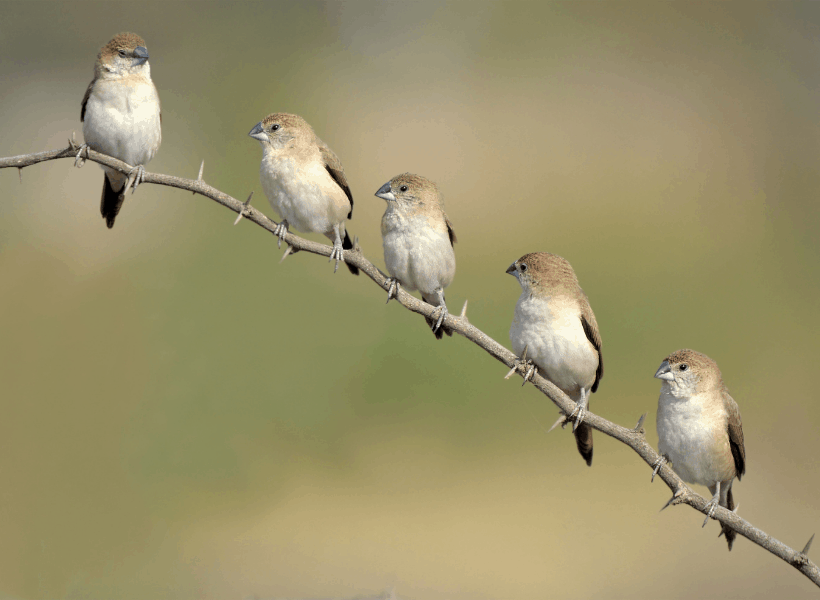
Both species now come in various mutations in captivity, where they are popular birds that are easy to care for. These mutations include albino, cremino, pastel or opal in the Indian as well as darker mutations in the African. Birds can cross breed with the other species.
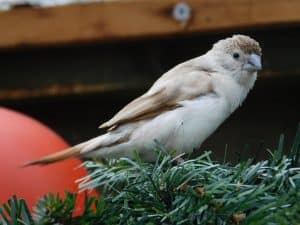
Caring for these birds is relatively simple. They like a good foreign finch seed mix with egg food and sometimes will take live food if offered, though this isn’t necessary for breeding. I personally found them best in a colony in a flight rather than in cages where they became relaxed and even come to the hand for food.
Others have success cage breeding so much depends on the temperament and background of the bird. Generally, the Indians will be seen in groups while the Africans tend to go off in their pairs. Heat is needed to protect them from the worst of the winter.
Clutches of 3-5 eggs are common though some breeders note more than this. They will use finch style nest boxes or build their own nests where the opportunity presents itself. Incubation lasts for around 11 days and other birds may help with duties if the parents allow it. They fledge at around 20 days and are independent from their parents at around two weeks after this. Parents and fledglings will often return to the nest at night to roost and some breeders recommend moving young to allow parents to have another brood.
Pearl Headed Silverbills
Another less commonly seen species of silverbill is the Pearl headed Silverbill. These look more like the mannikins in their stature and size but they are all family! The birds are seen in captivity, I did have a pair once but sadly not for long.
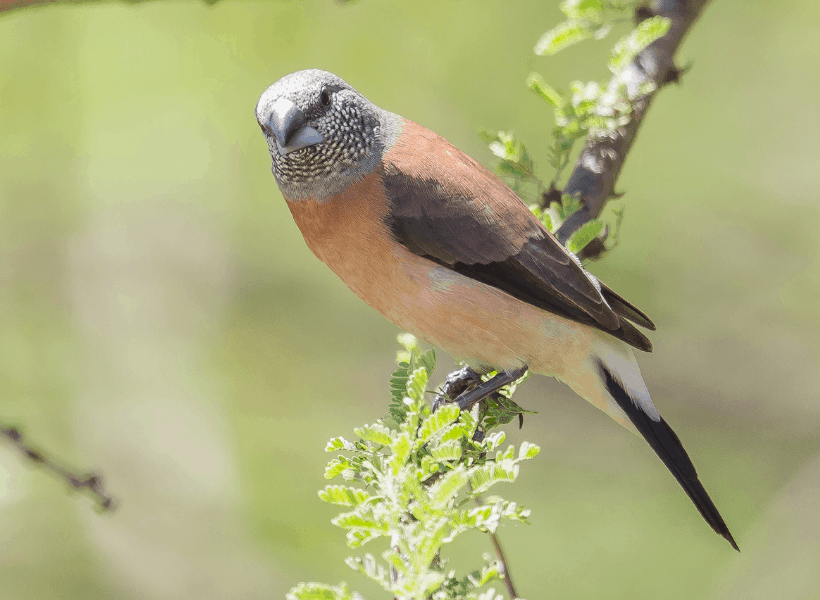
White headed munia
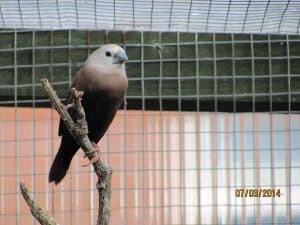
The White headed munia (Lonchura maja) or nun as it is often known, is another species found in captivity in the UK. These birds originate from Indonesia, Malaysia, Singapore, Vietnam and Thailand where they live in wetland habitats with plenty of marshes, reed beds and bamboo. They are around 11cm in size with a white head, pale brown throat and upper areas then a dark brown body and tail. Sexes are similar though the female is said to have a duller head colour than the male.
These birds are described as shy at first then quiet and sociable once they settle in, rarely looking for trouble amongst other residents. They do often check other birds’ nests but are not destructive in doing so, merely curious. They are often best left in groups to allow them to pick their own mate. They also benefit from an aviary with plenty of plants including bamboo and willow, the stems of which are used to keep their nails trimmed. Heat is needed to protect them from the worst of the weather.
Some breeders note they favour some of the larger seed mixes while others have found a good foreign finch works perfectly. They enjoy soft food and paddy rice in addition to their normal diet while live food may be taken by some birds though isn’t needed for rearing.
Nests are made from coconut fibres, long grasses and feathers though they will also use a half-open finch nest as a basis. They lay 3-7 eggs that are incubated for around 13 days and the young fledge at 21 days. They stay with their parents for another 2-3 weeks and are a dusky brown colour when they fledge so can be easily mistaken for other mannikins.
Other mannikins species
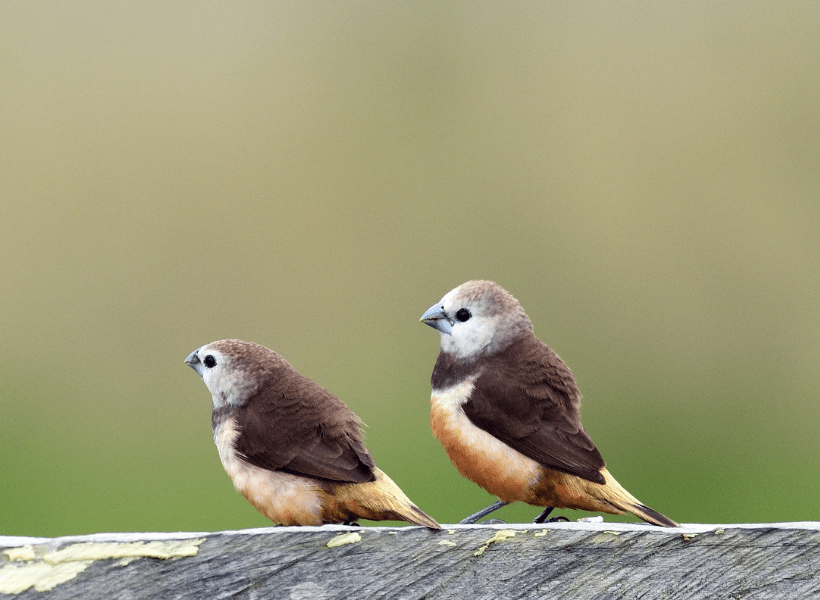
Grey Banded Mannikin 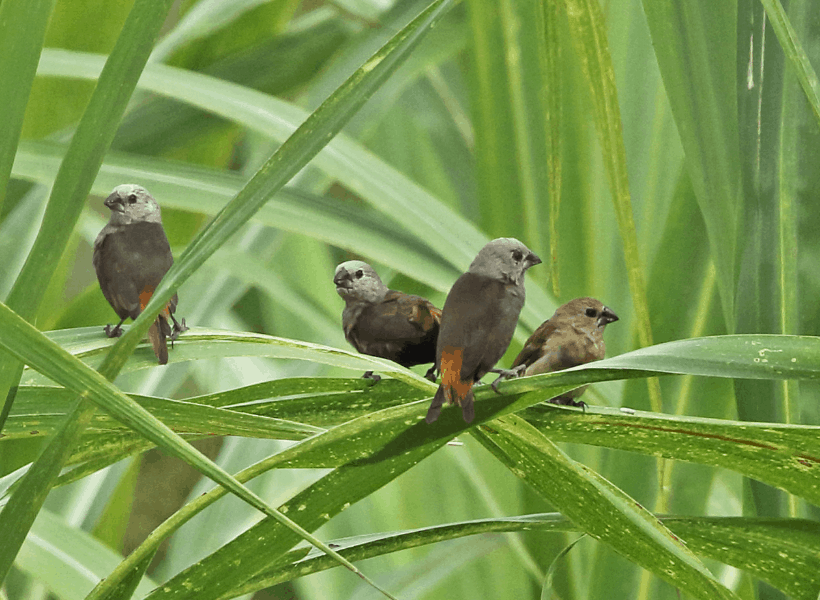
Grey Headed Mannikin 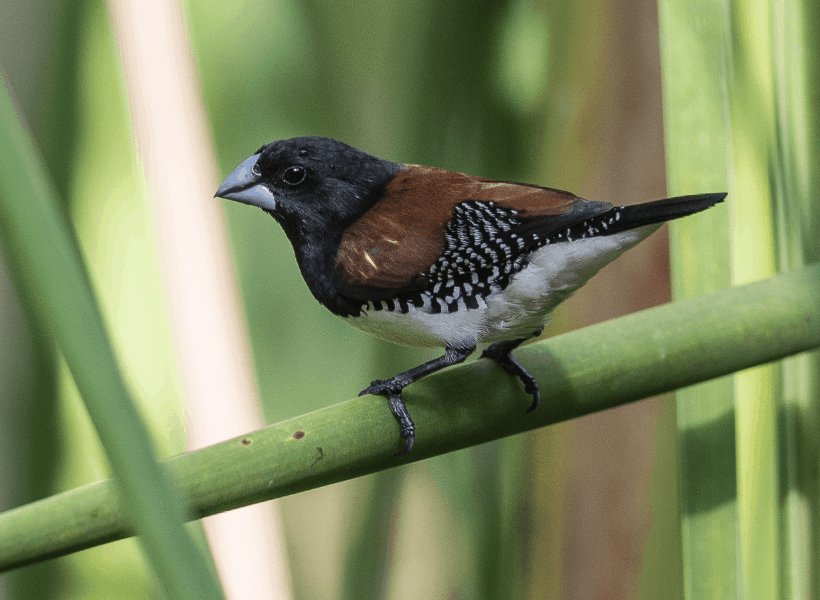
Rufous Backed Mannikin 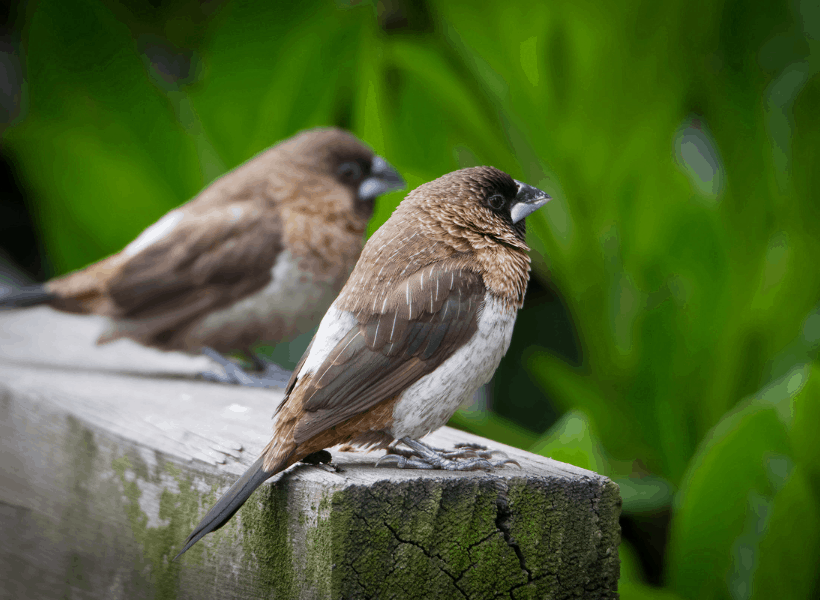
White Rumped Mannikin (wild Bengalese)
This article was written with invaluable personal observations from Mark Price – thanks Mark!
Further reading (good prices on the second hand option!)

Where can I buy white headed munia
Hi Edwin. It depends where you live but for me I get a lot of leads for birds through Facebook groups. So I would search for groups in your country and start asking around – someone might know of a breeder and you can reach out to see if they have birds for sale.
5
hi
Are black & white mannikins sociable in a group i have one flight with mixed finches & another with cuthroats
Do they require much heat during winter
Thanks
Black and white mannikins have a bit of a reputation of being a little troublesome in a mixed flight, especially with other mannikin species. Cutthroats can usually look after themselves, it might be more timid birds you need to watch. And temperature depends a lot on what they are used to. They are tougher than waxbills but not designed for UK winters so would definitely need heat and protection from cold and drafts.